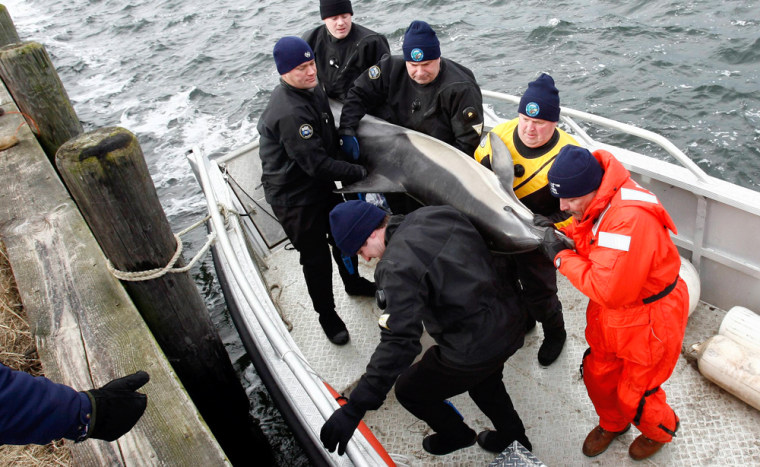The death toll of dolphins trapped in a shallow cove has risen to 10 and it is unknown how many weak and hungry members of the group might remain alive after a weeklong rescue effort, officials said Saturday.
At least two of the dolphins had empty stomachs, said Charles T. Hamilton, regional emergency response coordinator for the state Department of Environmental Conservation. Necropsies were ordered on the others.
About 20 of the "common dolphins" were first seen about 10 days ago in the Northwest Harbor cove, north of East Hampton, attracting spectators and marine biologists who feared for their safety.
More than 80 people have been involved in the rescue effort. The 10th dolphin's body was found midmorning Saturday, officials said.
Chuck Bowman, president of the Riverhead Foundation for Marine Research and Preservation, said that rescuers could not go out on boats Saturday because of strong winds.
The common dolphin in the wild feeds only on live fish, which the cove does not have, said Bowman, one of the leaders of the rescue effort.
"Time is not on our side," he said.
Ordinarily, the dolphins stay about 30 to 80 miles off shore but were likely chasing some bait food like mackerel or squid closer to the coast when they swam into waters that separate the twin forks of eastern Long Island, likely during high tide.
Eight were coaxed out of the shallow cove and swam away earlier this week.
Although a rare occurrence on Long Island, dolphin strandings are an annual event in places further north, including Massachusetts’ Cape Cod, said Tony LaCasse, a spokesman for the New England Aquarium.
Unlike the better-known bottlenose, or “Flipper” type dolphins found in southern waters, the two species are usually found year-round off Long Island and into New England, LaCasse said. They are usually six or seven feet long and weigh about 250 pounds or more.
William Wise, director of the Living Marine Resource Center at Stony Brook University, said Wednesday the dolphins may have chased a school of herring, mackerel or squid into the cove during a high tide. Then their internal defenses prevented them from traveling back through an inlet they consider too shallow.
Scientists tended to doubt speculation that the dolphins moved toward the coastline because of the unusually warm winter that Northeasterners had been experiencing until a recent cold snap.

“They are fairly adapted to cool water,” Wise said. “The difference in water temperature is not that great. It’s more of a question of disorientation in shallow water and a lack of food; that’s a greater threat.”
LaCasse said scientists were first focusing on rescuing the dolphins before they investigate exactly why they became lost.
“Dolphins are extremely social and can panic just the way people panic; they are very bright,” LaCasse said.